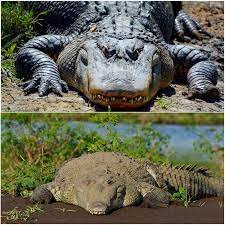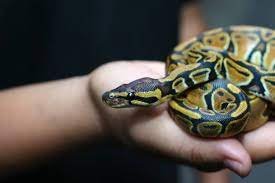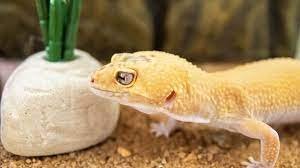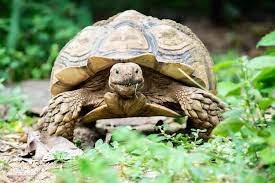Numerous species of lizards known as geckos are common house pets in the United Kingdom. They are a highly adaptable group whose most frequent members are the wall gecko found in almost every region of the planet. Geckos are great pets for both novice and seasoned herpetologists since they are small, colorful, and easy to find. Some points to keep in mind hold true regardless of the species of gecko you intend to acquire: Before bringing a gecko into your home, you should always strive to buy one that was bred in captivity, and learn as much as possible about its special care requirements, and build a suitable enclosure for it.
Leopard Geckos

Ground-dwelling geckos like leopard geckos are among the most popular pets in the reptile trade. They are nocturnal, burrowing animals that can be found natively in Pakistan’s arid regions. They spend most of their time underground, emerging only to sun themselves for a few minutes each day. They come out as the sun goes down to get ready for the night and to go hunting.
Yellow-Headed Day Gecko

Among the Day Gecko species is the Yellow-Headed Day Gecko. Easy-to-care-for and colorful, day species make excellent pets. If you’re just starting off and want a Gecko with some bright colours, these are a fantastic option. The Yellow-Headed species of Day Geckos are distinguished from others of its genus by their small size, vivid neon stripes, and cooperative nature toward other lizards. Due to the cooperative nature of females, it is possible to house several at once. Grows to a maximum height of only 4 inches at maturity.
Crested Geckos

Because of their attractive appearance and low maintenance requirements, crested geckos are our best-selling arboreal gecko species. As they don’t grow too large and don’t require a lot of extra heat, they are perfect for including in beautiful bio-active terrariums. They aren’t generally aggressive and, with some training, are simple to care for and manage. They typically come in a range of yellows, beiges, reds, and oranges.
Frog-Eyed Gecko

Frog-Eyes are often misidentified as leopard lizards because of their superficial similarities. However, they are noticeably bulkier and lack colorful designs. They often have a yellow-tan coloration and a white underbelly. Intense brown, tan, and brown spots cover their bodies and skulls. Central Asia is home to the frog-eyed gecko, which prefers a hot, dry climate. In order to keep them happy and healthy, a beginner should maintain an enclosure temperature between 84 to 93 degrees Fahrenheit.
African Fat-Tailed Gecko

When you first see one, you might mistake an African Fat-Tailed Gecko for a brown Leopard Gecko with a bit more baggage. African fat-tailed geckos, like leopards, have eyelids but no toe ridges for climbing. However, African Fat-Tails are native to the dry regions of West Africa between Cameroon and Senegal, whereas Leopard Geckos are from southern Central Asia. Many members of the gecko-keeping community are lovers of the African Fat-Tail, however, it has not yet achieved the kind of fame enjoyed by the Leopard Gecko.
Also, know 500 Of The Most Popular Lizard Names
Leachie Gecko

New Caledonian Giant Gecko is another name for the Leachianus. One of the largest species of pet geckos is the leachie. Adults can grow to be over a foot in length, making them unusual pets. The average gecko is less than six inches long. Particularly notable are the distinctive calls made by leachies. Since they are active only at night, they make a lot of noise all through the silent hours.
Giant Day Gecko

When compared to other day geckos, the huge kind is noticeably larger. This gecko prefers daylight and is therefore classified as diurnal. This lizard is an eye-popping shade of green, and its bright red markings really stand out. It’s hard to find a more stunning gecko than the huge day gecko for use in zoos and private collections. It’s a big, colorful bird that flies around during the day. It will often climb up the window and investigate you as you pass by or approach with food.
Gargoyle Geckos

If you’re looking for an alternative to crested geckos, it is highly recommended gargoyle geckos. Both species originate in New Caledonia and require very comparable care and have very similar personalities, albeit the gargoyle gecko is a little less timid and more tolerant of attention than its New Caledonian counterpart.
Chahoua ‘Chewie’ Gecko/Mossy New Caledonian Gecko

The Chahoua, or chewie, gecko, is a multi-named species that resembles a cross between the crested gecko, the gargoyle gecko, and the leachie gecko. It is also known as the mossy New Caledonian gecko and the short-snouted New Caledonian gecko. This creature resembles the gargoyle in snout and tail tip, the crested in tail shape and eyelashes, and the leachie in overall coloring. The chewie gecko may blend in with its environment by mimicking a patch of moss on a branch.
Tokay Geckos

Tokay geckos are a noisy, erratic, and sometimes dangerous species of gecko native to Asia. They’re fantastic gecko, colored somewhere between blue and grey with spots of orange and brown on their back. We do not recommend them as a first pet reptile because of their difficulties in taming out, but like many species, they can tame out well over time and be very rewarding pets for a patient, experienced keeper.
Flying Gecko

Indonesia is home to the Flying Gecko, which lives in the canopy of trees. This pet gecko seems mossy because of its combination of brown, black, and tan coloring. They are able to blend in with their surroundings thanks to their looks. This incredible animal uses its webbed toes and flat tail to “fly.” By drawing its feet in and flapping its tail, this gecko is able to do impressive tree-to-tree leaps. Captive environments are not conducive to the flight behavior of flying animals.
Madagaskar Ground Gecko

The vivid patterns and shades that the geckos of Madagascar are known for fascinating their human keepers. Their auburn eyes complement their red brick skin and brown, tan, and white speckles. The species found in Madagascar are a great choice for beginners. They don’t live in a tank as most geckos do, and they can scale walls just fine.
Gold Dust Day Gecko

Celebration of the Golden Dust Madagascar is home to a green lizard species known as geckos. This snake’s basic color is green, and it’s patterned in red and blue. The term “Gold Dust” comes from the tiny, bright golden specks seen all over their surface. We conclude with the Gold Dust Day, the third and final species of Day Gecko we’ve covered. This lizard is smaller than the average (like the Neon Day). Compared to their Giant Relatives, they also come in a wider range of colors.
Chinese Cave Gecko

As a result, more and more pet shops are stocking Chinese cave geckos. To put it simply, they make beautiful pets. With the exception of their color, these lizards resemble leopard geckos and African fat-tailed geckos quite closely. Like the cool cousin of the goofy and dorky leopard gecko, these geckos are very badass. They are available in a wide variety of black and red patterns, including solid black, black with yellow and black banding, grey with black spotting, and red spotting on grey. These geckos are a sight to behold.
Knob-Tailed Gecko

The Australian knob-tailed gecko is the last but surely not the least. The tail of this gecko is one of the most peculiar of any animal. It is cylindrical with a protruding worm-like knob. Being relatively novel to the pet industry, they can be quite pricey. In addition, they are the only lizard on this list that can legally be kept in Australia by reptile keepers. To avoid damaging their sensitive skin, always proceed with caution.
Conclusion
Investigate the needs of the geckos you’re considering if you’re seriously considering getting one. Look for a dependable breeder. Geckos Unlimited and the Gecko Forums are great places to meet breeders and experienced gecko keepers. They are the go-to resource for all things gecko-related and can help you get started on the path to many years of pet ownership satisfaction.





